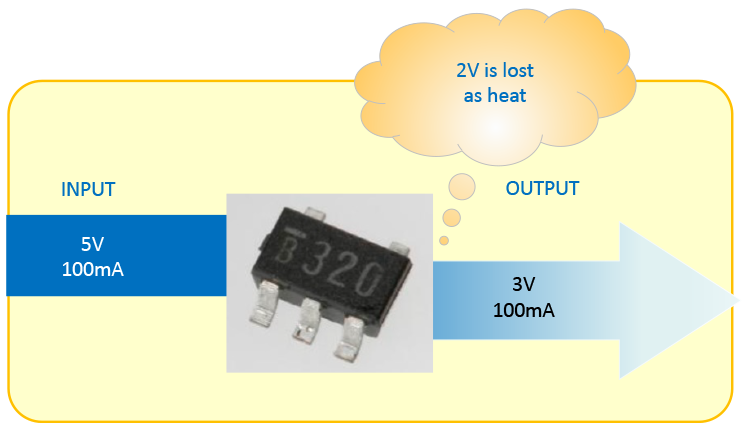This section explains loss and heat generation, which are disadvantages of voltage regulators.
Voltage regulators have driver transistors/FET built into the IC as variable resistance, which is used to adjust the resistance value to maintain a constant voltage.
This IC internal variable resistance (driver transistor/FET) internally steps down the voltage of the dropout voltage from the difference between the input voltage and the output voltage. The voltage stepdown and current flowing in the IC (=output current) from this variable resistance causes loss and generates heat in the IC.
For a specific example, consider when the input voltage is 5V, the output voltage is 3V, and the output current is 100mA.
The 2V that is the difference between the 5V input voltage and the 3V output voltage is stepped down inside the IC. The current flowing in the IC is the same 100mA as the output current. (Strictly speaking, there is a small difference due to the consumed current, etc.)
This voltage difference of 2V and the 100mA current flowing in the IC result in a power loss in the IC of 2V x 100mA = 200mW, which generates heat in the IC.

(VIN – VOUT) × IOUT = Heat loss
The larger the voltage difference between input and output,
the greater the loss as heat generation.
As can be seen by this formula, the IC loss becomes larger the greater the dropout voltage and/or the output current, which adds to the amount of heat generated in the IC.
In this example, the input voltage of 5V is converted to an output voltage of 3V, so the difference is 2V, but if the input voltage was 24V and this is stepped down to 3V, the difference would be 21V, so with an output current of 100mA, the loss would be 2.1W.
Further, as the amount of heat generated increases, the junction temperature increases, so measures must be taken to dissipate the heat to keep down the junction temperature.
Under conditions where the junction temperature exceeds that of the IC’s absolute maximum rating, changing to a high heat dissipating product or to a switching type DC/DC converter must be studied.